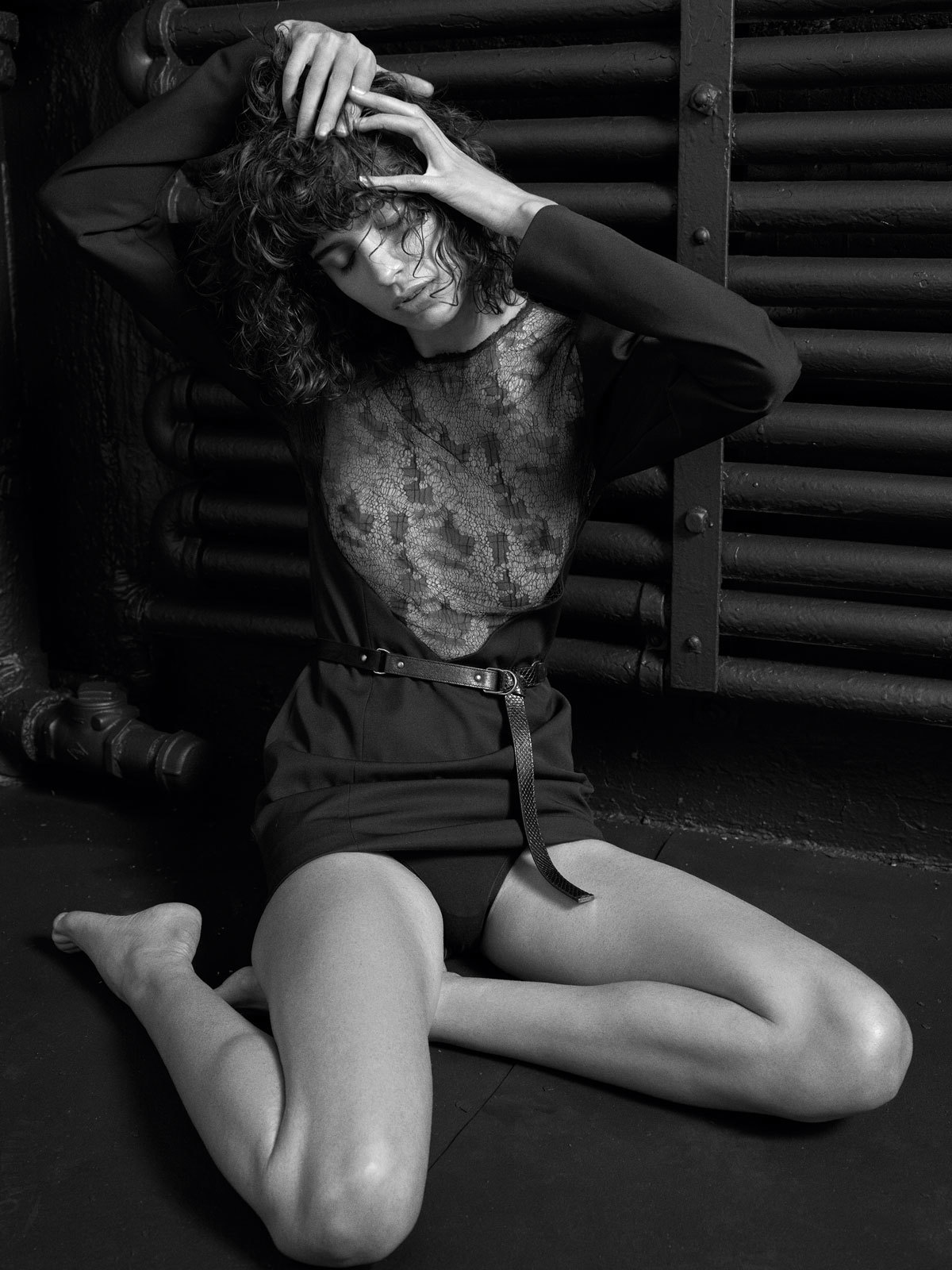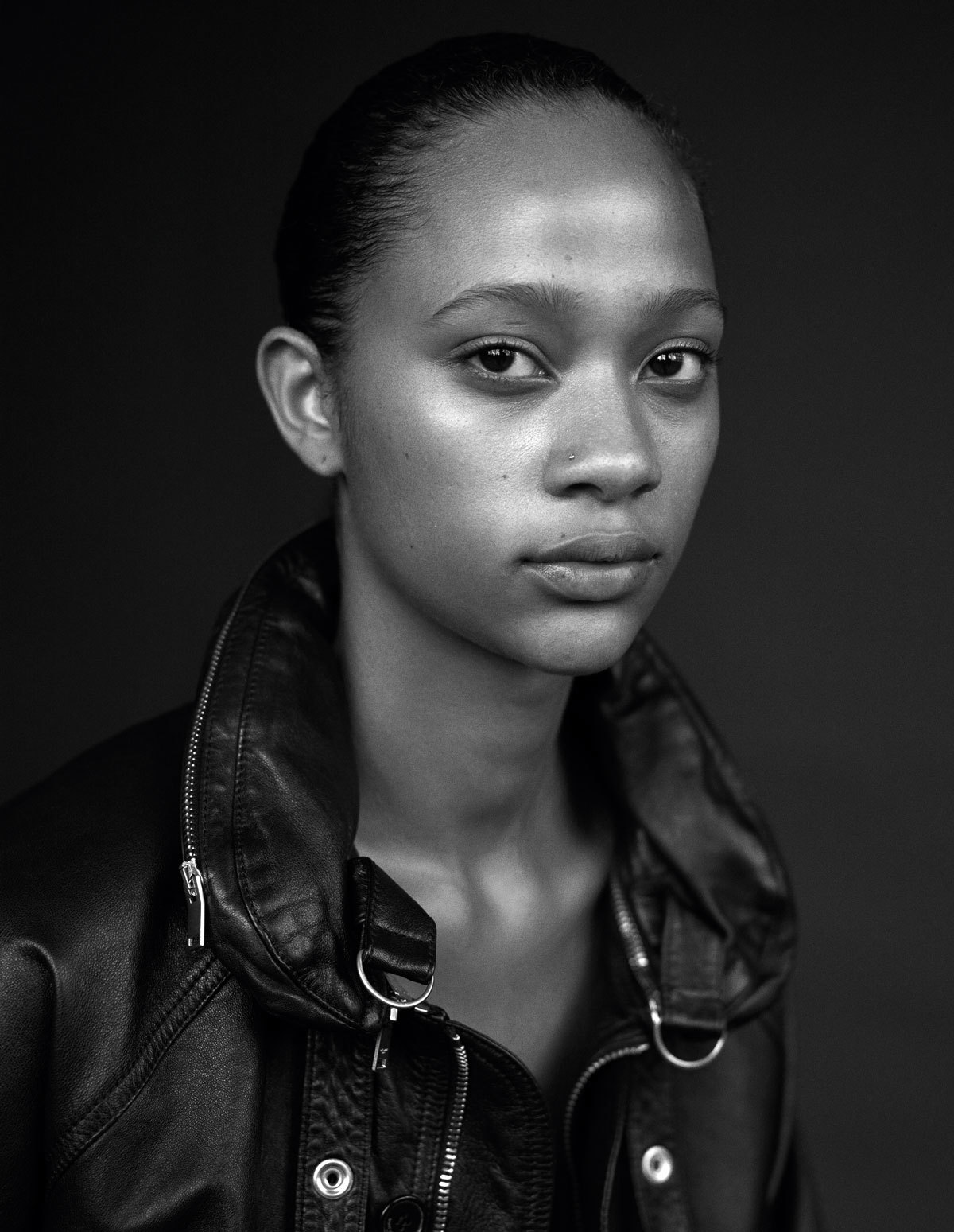
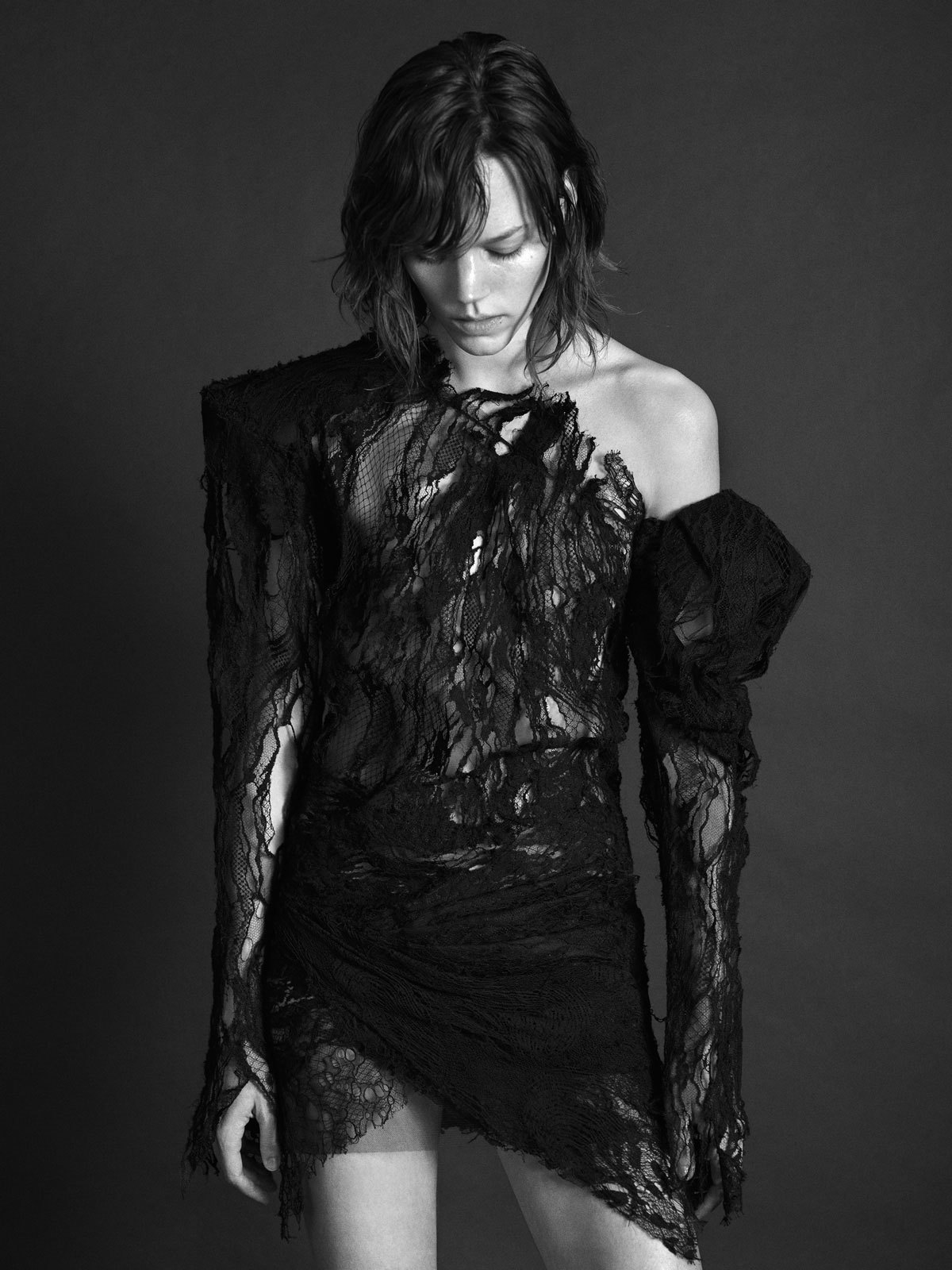
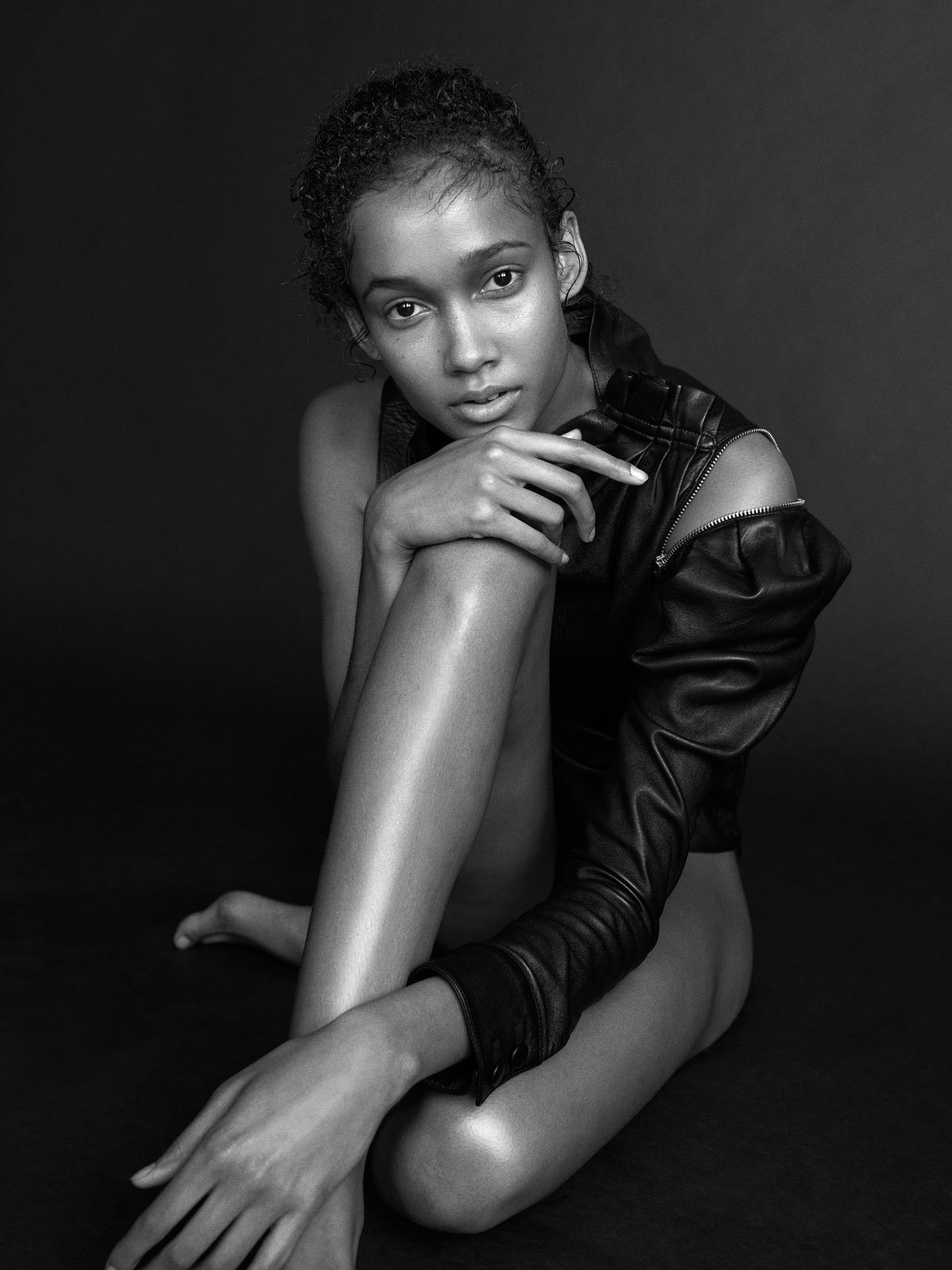


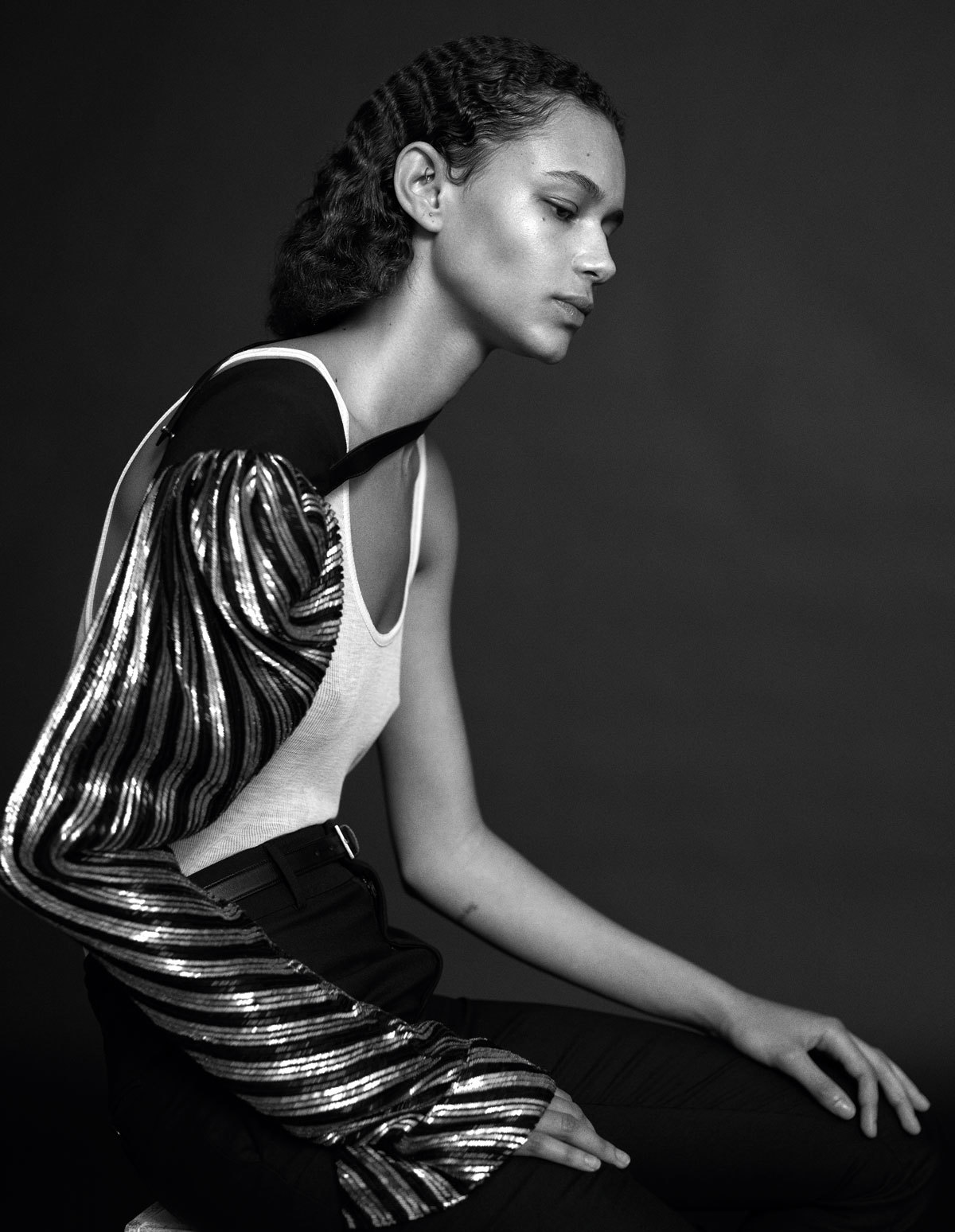
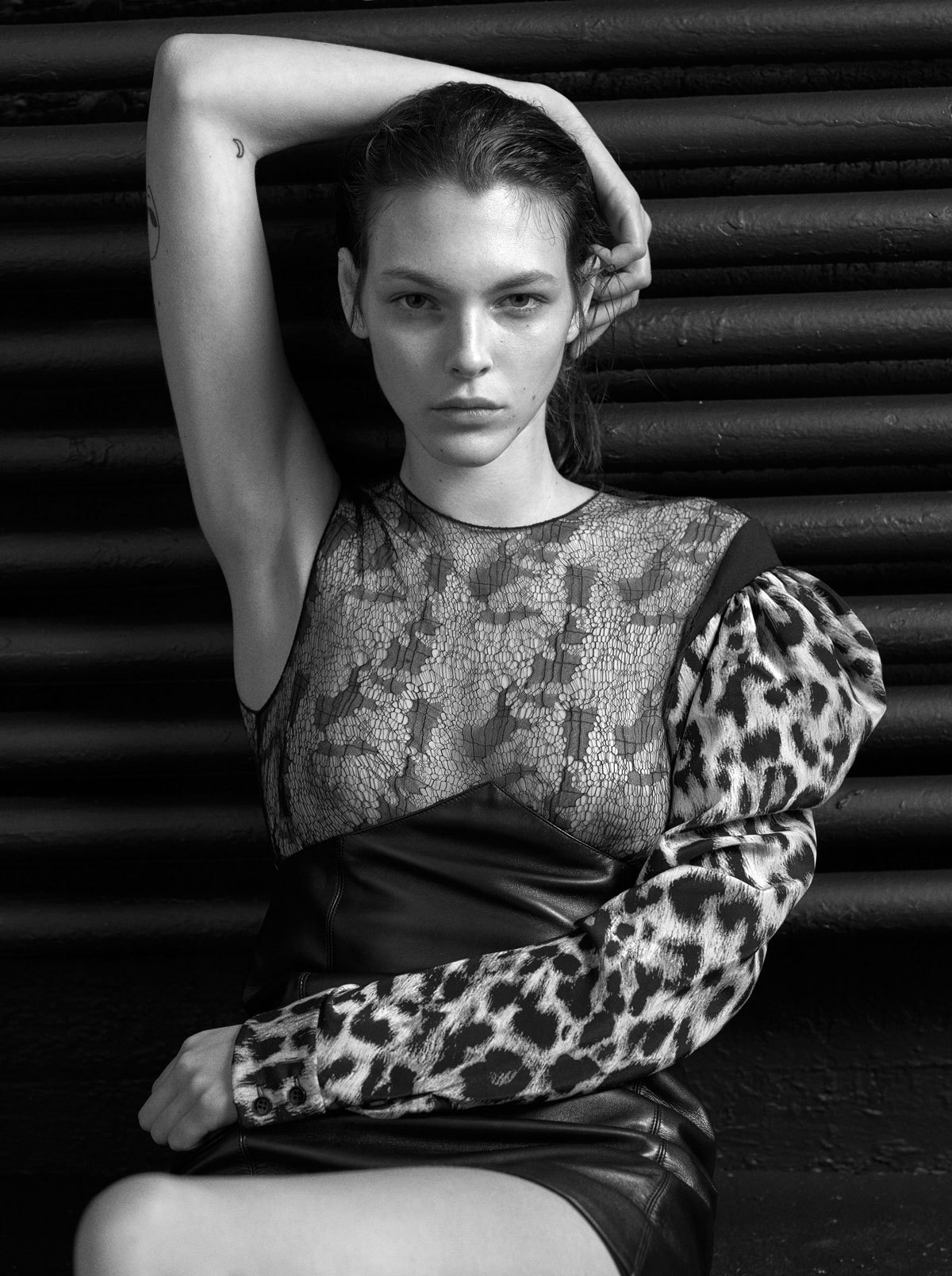
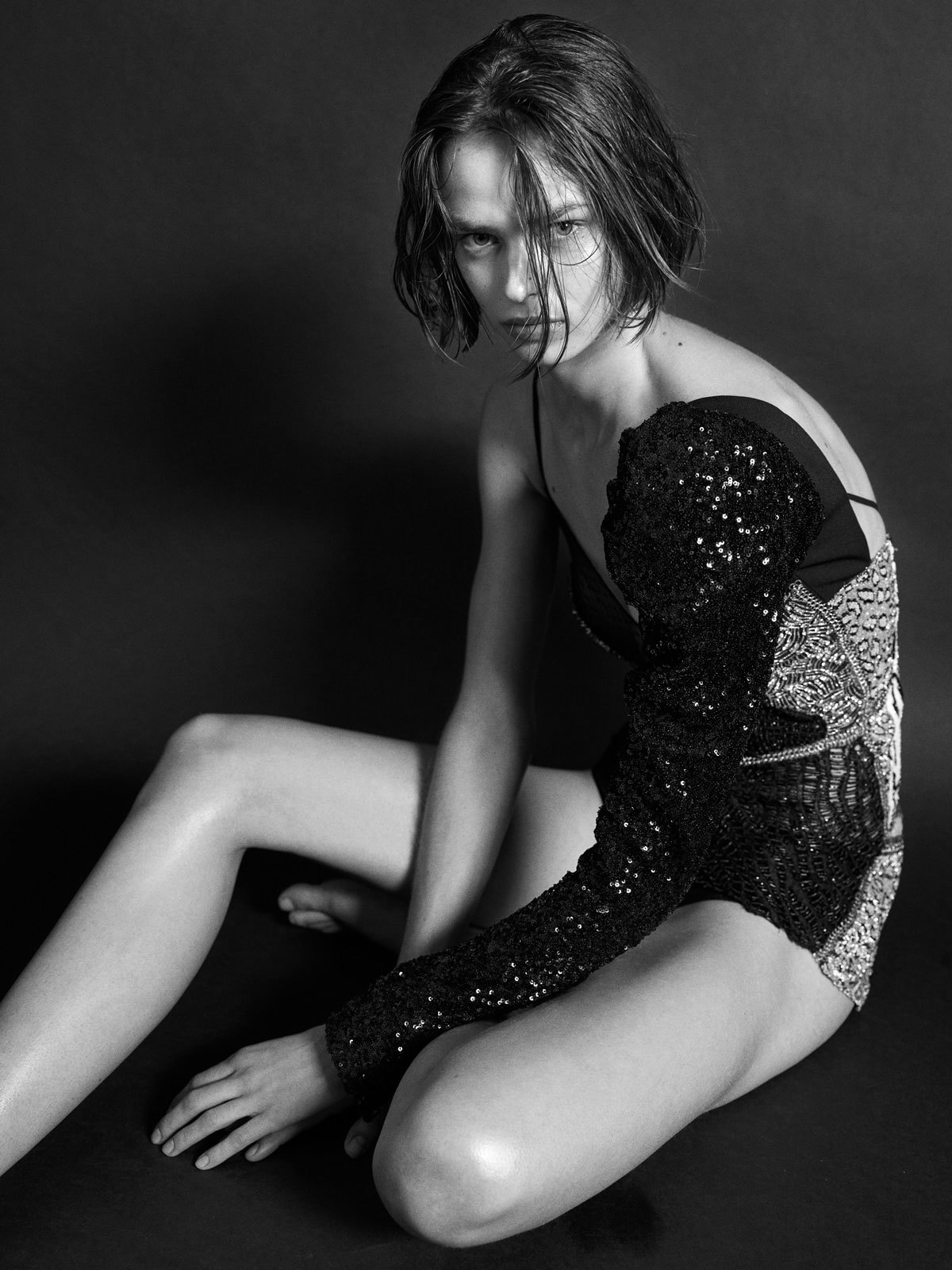
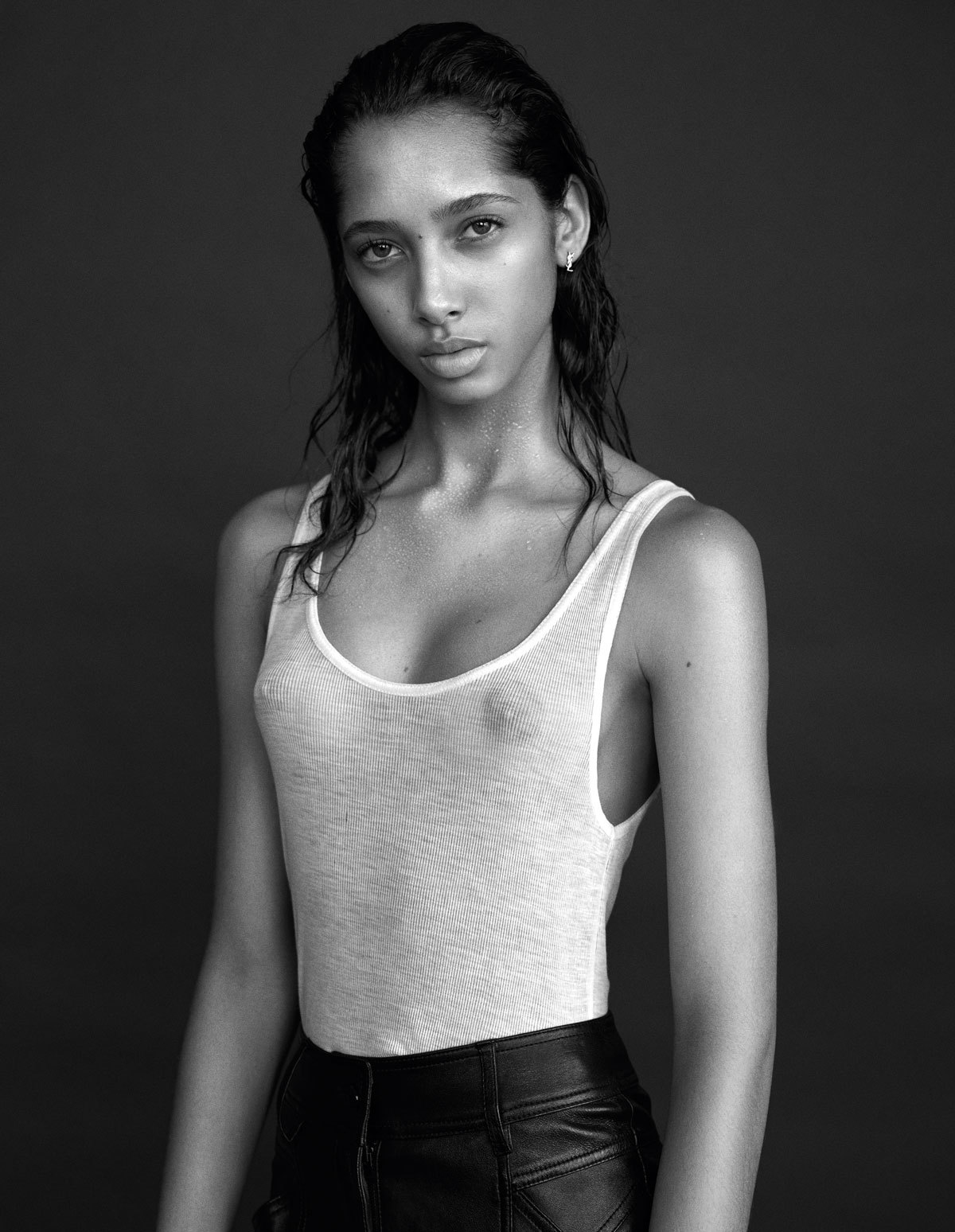
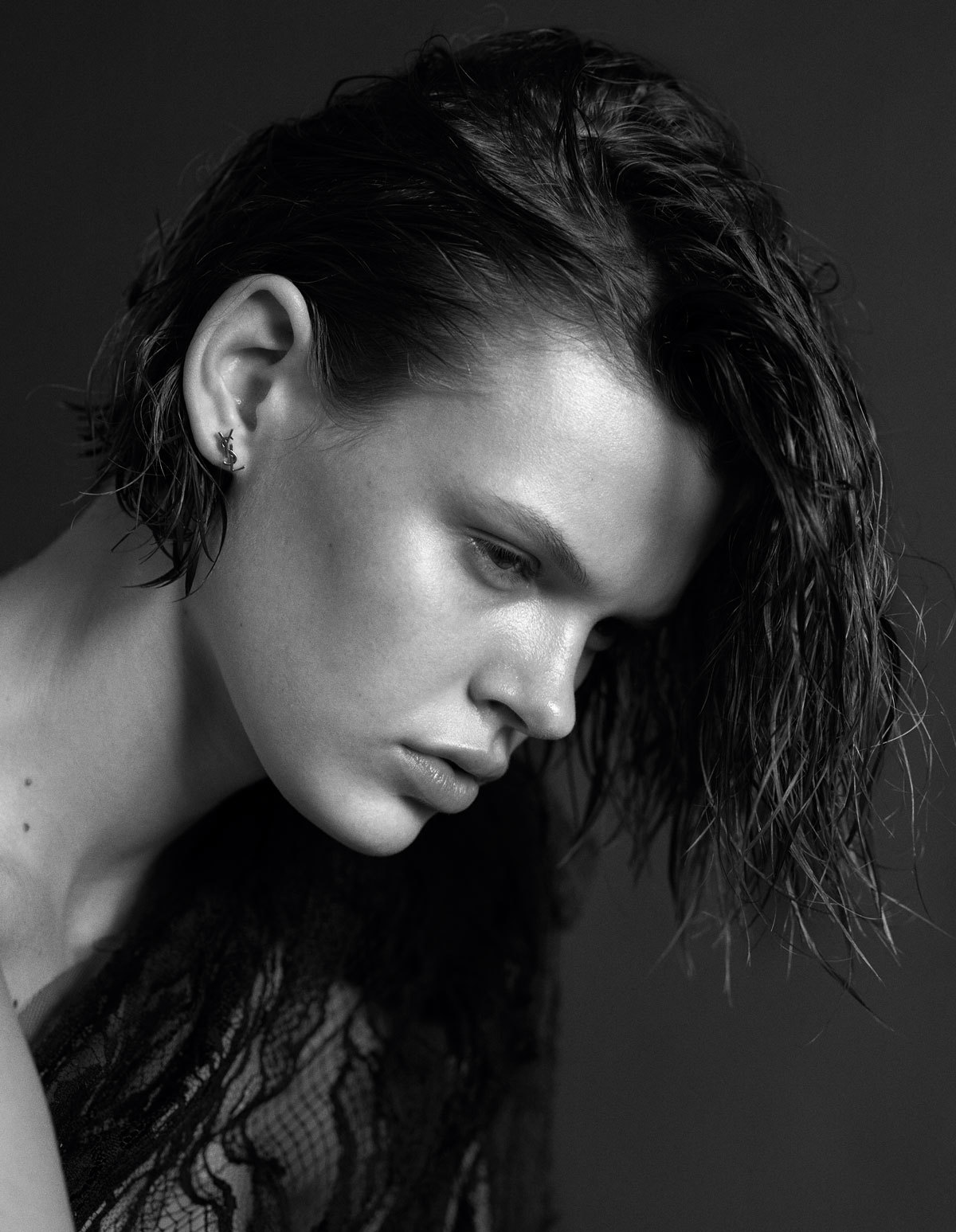

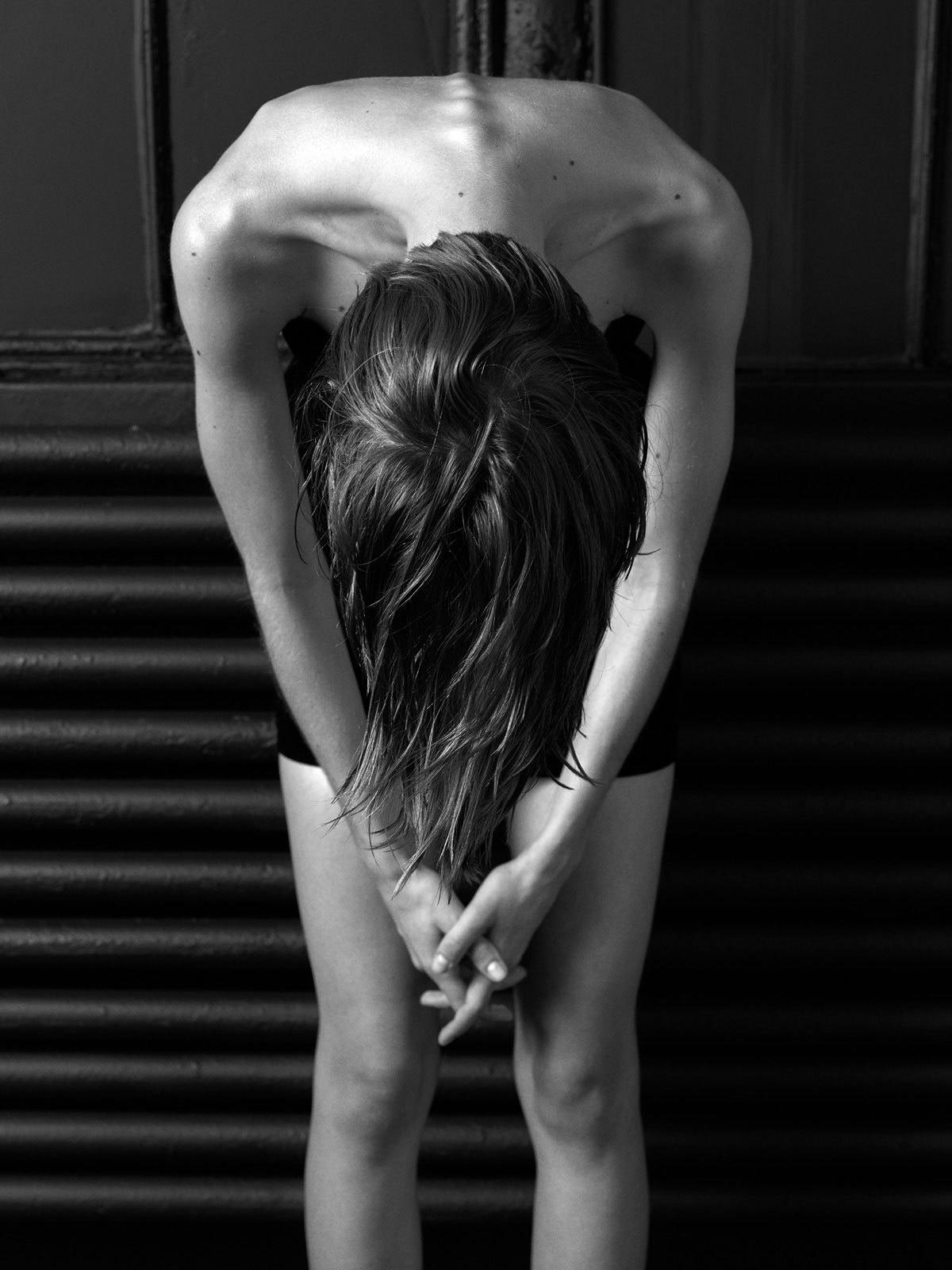
It didn’t take long for Anthony Vaccarello to cross the river after taking the creative director job at Saint Laurent in early-mid 2016. Nestled in Saint-Germain-des-Prés in the heart of Paris’ chic Left Bank, his new apartment comes with a roof terrace, easy access to Café de Flore, and occasional sightings of Catherine Deneuve. “I saw her twice, smoking,” he whispers. Our last formal rendezvous took place in his bedroom some two years ago, in the tawdrier surroundings of his former home off rue Saint Martin, which also housed the modest studio for his eponymous label, Anthony Vaccarello, which he put on hiatus when he landed Saint Laurent. “But in a way I’m missing le droite,” he admits, referring to the other side. “I’m kind of stuck here. Sometimes I need to feel dirty and le droite. I don’t know – I was complaining about the pee on the street before, but now I’m missing something real,” he shrugs, the chilly white stucco ceiling of the palatial Yves Saint Laurent headquarters – not far from his new home – hovering over his head.
Has fashion life at the top made Anthony Vaccarello bourgeois? “No, I don’t want to – I’m forced to be bourgeois,” he retorts, his under-the-breath voice at maximum soft-spoken volume. “If you work in this kind of atmosphere you cannot be punk. I mean, you can, but it’s ridiculous. In a way you slightly go into it, I think.” Entering the gate and passing his big, black chauffeur-driven Mercedes in the courtyard of the ateliers, or walking through his supersized office, desk-free but with a massive sofa, you can’t blame him. After years of the never-ending student-life existence that comes with being a young, independent designer, who wouldn’t trade in their Skoda for a Benz, so to speak? “Well, the car is going faster but the ride is the same,” he quips. “You’re taking the same road.” Life in the fast lane, he says, isn’t as different as you’d think. “I’m still here from 10am to very late, working. You’d think being the director of a big fashion house like this is a completely other life, but that doesn’t interest me. I’m still surrounded by the same team and the same everything, except it’s more beautiful.”
Vaccarello brought his entire team with him to Saint Laurent, integrating them into the enormous staff he now oversees, a number in the hundreds so daunting he doesn’t have an estimate. And maybe it’s for the best. This designer is anything but grand. Sitting quietly in the majestic antechamber in his headquarters – black jeans and a black sweater – his contrasting modesty speaks volumes of the decidedly un-hysterical approach he’s maintained to his monumental new position since the appointment in April last year. For months, it was the worst kept secret in Paris, dream fodder for the salivating gossip girls of fashion, who could barely sit still at shows for what was unfolding: fashion wunderkind Hedi Slimane, with his cult following and skyrocketing sales, would leave Saint Laurent to be replaced by a next-generation designer twenty years his junior. Déjà vu ensued to the summer of 2007 when Slimane parted ways with Dior Homme, leaving its future in the hands of Kris Van Assche, who would feel the weight of his legacy in years to come before his own Dior Homme was fully accepted.
“Hedi really invented a silhouette for Dior Homme, and he didn’t for Saint Laurent, so it’s very different. For Dior Homme it was really a new silhouette and that’s hard to follow. And also, he was the assistant of Hedi,” Vaccarello points out, referring to Van Assche’s previous position, “and I never met him. That’s also why I’m not scared, because I’m just doing what I’m doing for myself.” In the months leading up to his debut collection in September 2016, Vaccarello only sought the advice of one man, Pierre Bergé – the 86-year-old former partner of Yves Saint Laurent – whose words to him in their first meeting have been echoing in his head ever since: “You’re not Yves Saint Laurent. Don’t try to be Yves Saint Laurent.” It was the freedom he needed to inhabit the historic house established in 1961 by Bergé and Yves Saint Laurent, who wasn’t a stranger to the balancing act between bourgeoisie and rebellion now performed by Vaccarello.
“He hated all that. But in a way he was very bourgeois, the way he lived and the crowd he was surrounded by,” the designer reflects. For Vaccarello, however, establishing his Saint Laurent didn’t become a question of pinning down parallels between him and Yves – or him and Hedi Slimane, for that matter. “It was not to continue what Hedi did or doing Saint Laurent, I just wanted to do what I did for myself,” he says, vowing he was never scared of the job he’d accepted. “I do it for myself, not for what people will say. I didn’t think about the comments. It’s impossible to make a perfect Saint Laurent collection, because everyone has their own vision of what a Saint Laurent collection should be. Since the first day, I knew that Saint Laurent is a passionate house – you love it or you hate it, since the beginning; since Yves Saint Laurent, since Tom Ford, since Alber Elbaz,” he says, listing his predecessors in the role. “Hate it or like it, I’m doing this.”
Those on the fence perhaps had a hard time uniting Yves Saint Laurent’s cuttingly romantic forms with the trashy sex-bots of Vaccarello’s runway. But in the 36 year old’s distinctly Belgian-Italian fusion between introverted boy soul and in-your-face sass bomb, you could easily draw parallels between the novice and the master. Saint Laurent was deeply multi-faceted, one minute the whimsical recluse, the next the intellectual charmer, then suddenly posing naked in his most famous portrait ever. A polite creature with a mischievous mind, Vaccarello was born in Brussels in 1982 to a restaurateur father and a secretary mother and grew up – not surprisingly – on the femmes fatales of 80s and early-90s television: the broad-shouldered boardroom broads of Dynasty followed by the bold and beautiful bitches of Melrose Place, and the teen-tastic new 90s attitudes of the girls on Beverly Hills, 90210 and Heartbreak High. He lost himself in va-va-voom music videos on MTV, in Mariah Carey, Madonna and her Sex book, “sometimes Celine,” and the supermodels, who have never fallen from Vaccarello’s grace.
Throughout these eras, Yves Saint Laurent was one of the strongest shapers of fashion and image culture in the world – even if a young Vaccarello was more into Thierry Mugler and Jean Paul Gaultier. So doing Saint Laurent, as it were, quickly proved less of a contrast to the influences that had fed his previous body of work than some early Instagram comments would have it. “I think they hired me from what I built myself, my own company, and the vision I had for Vaccarello,” he says of the label he founded in 2009 after graduating from La Cambre and working for Fendi. “I’m working with that vision here, basically, just with an archive and being inspired by what Yves Saint Laurent did,” he says. “But I didn’t reproduce what was already done. When I look at my old collections there was always a spirit of Saint Laurent in the attitude, so things were very natural.” For his debut collection for the house, Vaccarello avoided the obvious route, steering free of the signature Saint Laurent pieces he’d seen at the Fondation Pierre Bergé Yves Saint Laurent, which Bergé encouraged him to visit.
That is, except for one: “I had fallen in love with a dress since seeing it in the atelier for the first time.” It was a fall/winter 81-82 black gigot-sleeved velvet number with a heart-shaped décolletage and a taffeta pouf skirt, created the year before he was born. Like a sign from above, when Vaccarello got to the Fondation it was standing next to Yves Saint Laurent’s office. “I thought, right, that’s the direction I have to take. But I didn’t want to just take it and cut it like a mini-dress. I wanted to play with the collection as a collage, taking one sleeve from that dress, playing with leather. I wanted it to be Saint Laurent in the attitude more than in the clothes.” What materialized was a woman true to the empowerment Vaccarello conveyed at his eponymous brand. “Yves Saint Laurent liked having that sheer T-shirt or dress, but it wasn’t sexual or seductive – for me she’s the equal of the man. Nudity is not a shame. What he did was really, really sexy. It looks like nothing before. We really explored that woman: she’s proud of her body, she’s not hiding under tons of fabric.”
Unmistakably Vaccarello in skimpiness, the collection’s overriding 80s trash-glam echoed the early political waves of a spring/summer 17 season, whose Reagan-era mega sleeves and scanty hemlines hinted at the exuberant contrast of 80s fashion to the conservative zeitgeist embodied by the spirit of Cold War America – now revisited under Trump. When Vaccarello released his Saint Laurent campaign featuring two girls kissing, it triggered some strong reactions. “The US is refusing, Italy is refusing, all these countries, and I really don’t care, because I don’t want to change the vision I have for the brand because some countries are shocked about two girls kissing. So in a way it’s political but I didn’t want to make a political statement,” he says. “It’s something in the air, which I didn’t analyze too much, but last year in Paris was really strong in terms of everything that happened. I didn’t want to draw a parallel, but the 80s thing must be a reaction to what’s happening. I think as designers we must be sensitive to these things.”
What’s often overlooked in a day and age when designers jump between houses like commitaphobes is the indirect political power that comes with these jobs. Little do power-shopping Saint Laurent-wearing women in Dallas or Dubai know of Anthony Vaccarello’s political beliefs, but they’ll buy and wear the clothes embodied by his core values. And nothing could be more Yves Saint Laurent than giving a sly underhand to the establishment. As far as Vaccarello’s menswear goes – debuted alongside his fall/winter 17 women’s collection this February – the male customer is in for a ride, too. “I want him to be a bit feminine, because it’s always been a feminine house. You don’t think about a men’s silhouette at Saint Laurent, you think about him personally. I see him as very sensitive. He can borrow things from the women’s wardrobe,” he says, nodding at the one men’s look that found its way into his first show: a black bishop-sleeved transparent chiffon blouse, worn with nothing underneath.
“It’s very personal,” he smiles. “I’m making my wardrobe.” Asked if Chanel would like his work at her house, Karl Lagerfeld once responded: “What I do, Coco would have hated. It’s up to me to update it.” For his Saint Laurent debut, Vaccarello didn’t just have Slimane’s more recent successes looming over his head, but the weighty legacy of Yves Saint Laurent – a holy grail in the eyes the of fashion critics. “I only listen to comments from people I know and respect in the business – maybe three people,” he says. “A few more than three!” Lucien Pages, his publicist, quickly intervenes, laughing. “I don’t know if it’s correct to say this,” Vaccarello pauses, “but I don’t trust the reviews. It’s not like before when it was really true: you liked it or you didn’t like it. With all the advertising you can do a really bad collection and people say it’s amazing because they have to. Knowing that, I don’t respect it anymore. Only the few ones I really know are true to themselves.”
As for the bloggers, “I’m not sure they are important anymore – the look, sometimes more. You can easily buy them. You have to be a really new blogger to be independent, but as soon as you have followers brands put their hands on you, so I don’t trust them either.” Would Yves Saint Laurent have approved, then? “I thought about it, and for me the best way to know is Pierre Bergé. He came to the show, which touched me.” In the days after they met for lunch. “He really understands all the looks and where the inspirations came from. It’s very interesting to speak to someone, who’s not like, ‘Oh, it’s a sexy collection,’ but really sees what your references are. It’s good to speak to someone, who knows about Yves Saint Laurent, and isn’t about a cliché of one vision of him,” Vaccarello says. “Pierre Bergé is one of those guardians of the temple. He’s the one, and having his good review, for me, is like, I did it.”
Credits
Text Anders Christian Madsen
Photography Mario Sorrenti
Fashion Director Alastair McKimm
Hair James Pecis at Bryant Artists using Oribe. Make-up Diane Kendal at Julian Watson Agency. Nail technician Alicia Torello at The Wall Group using Dior Vernis. Set design Philipp Haemmerle. Lighting technician Lars Beaulieu. Digital technician Johnny Vicari. Photography assistance Felix Kim, Javier Villegas. Styling assistance Lauren Davis, Sydney Rose Thomas.
Hair assistance Adlena Dignam, Rebekah Calo, Clara Leonard. Make-up assistance Caoilfhionn Gifford, Angelina Cheng. Set design assistance Ryan Stenger. Production Katie Fash and Steve Sutton. Casting directors Piergiorgio Del Moro and Samuel Ellis Scheinman for DMCASTING. Models Wallette Watson at Supreme. Mica Arganaraz at DNA. Anja Rubik, Selena Forrest, Agnes Akerlund and Binx Walton at Next. Cara Taylor at Oui. Yasmin Wijnaldum, Birgit Kos and Vittoria Ceretti at Elite. Lexi Boling and Freja Beha Erichsen at IMG.
All clothing and accessories Saint Laurent by Anthony Vaccarello.
Wallette Watson, Mica Arganaraz, Anja Rubik, Selena Forrest, Agnes Akerlund, Binx Walton, Cara Taylor, Yasmin Wijnaldum, Birgit Kos, Vittoria Ceretti, Lexi Boling, Freja Beha Erichsen
